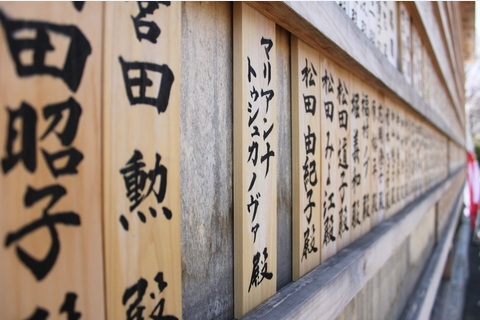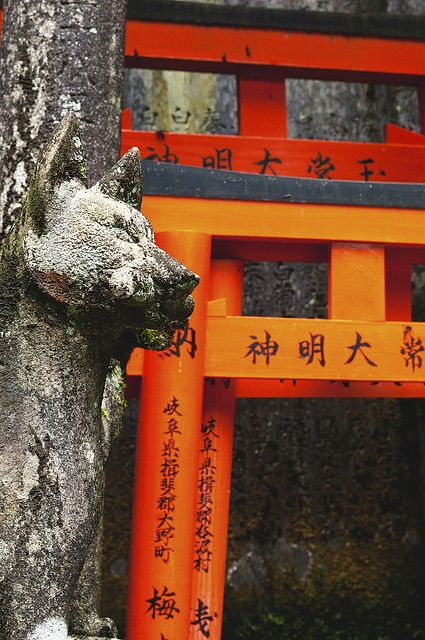Kanji are characters, derived from Chinese, and adapted into written Japanese. They can be the greatest enemy of people learning Japanese for the first time, but the greatest friend to those who stick with the language. Students of all levels of Japanese can appreciate the beauty, function, and communicative power these characters carry. Many of them show a deeper meaning when broken into their parts, as evidenced by one of the characters for listen:

聴
This particular kanji is often used to talk about “really listening”, as opposed to the common character for listening. “聞”. While the common way to write the “ki” part of “kiku” or “listen” has the character for “ear” (耳) incorporated, the more complicated and nuanced version of “ki” contains not only 耳, but also “eye” (目), and “heart” (心) as well. In two kanji characters that have the same pronunciation and basic meaning, one can be infused with a deeper meaning that would never be conveyed with only the phonetic hiragana or katakana renderings.
Learning kanji can take time, especially if you want to become proficient at handwriting them, not to mention the time it takes to master Japanese calligraphy (Shudo). It is however worth it when you can sit down with a newspaper or novel and breeze through it thanks to the power of a written language that can deliver deep meaning in a glance.

A Brief History of Kanji
Painting the story in very broad strokes, Kanji came from China. It was brought back, along with Buddhism and some other things, and incorporated into the culture at a time when China was cool. It is not only modern Japan that incorporates and adapts parts of foreign culture. Japan has been doing that for a very long time.
Exactly when, how, and by whom these funny little characters came to be the primary influence on Japanese writing is still subject to scholarly debate. The name of the characters themselves “Kanji” are the Japanized pronunciation of the Chinese word for the characters, “hanzi”. Both are rendered with the same characters shown here “漢字”, meaning the Han letters. Han, of course, refers to China’s Han Dynasty.
In the Nara Period, a Japanese poetry was collected into a book called the Man’yoshu. Here, the predecessor to modern hiragana and katakana was found in a style of writing called man’yogana.
Kanji was originally used, accompanied with notations allowing for Japanese speakers to better read and understand the Chinese, as well as to reconcile it with the Japanese spoken language already in use. Over time, the Japanese written language continued to distinguish itself from Chinese as new Kanji only in use in Japan were created, and as the pronunciations and meanings of the characters began to diverge from the original Chinese. Also, natural changes to the language, as well as official simplifications in both countries have led to a further divergence.
Simplification of Kanji After World War II
The natural development of Kanji and its adaptation from original Chinese characters led to the inconsistencies in Japanese writing as well as extraneous characters with the same pronunciation and meaning as others. In order to make the language more accessible to non-native speakers the official list of characters was brought down to a total of 1,850 characters, although slightly more are used commonly in names, place names, and technical and scientific terms among others. These are known as the Toyo Kanji.
In 1981, the list was expanded into what is known as the “Joyo Kanji” or “Regular-use Kanji”. Although there have been minor changes and additions to the list, the current number is 2,136. This includes the 1,006 basic educational characters that elementary school students in Japan are expected to learn between first grade and sixth grade. The last major revision of the Joyo was done in 2010.
In addition to these regular-use characters are characters that are used exclusively in personal and place names. These are called the Jinmeiyo Kanji. This list is frequently updated, in part to allow for trends in how children are named, and currently sits at just over 980.
Kanji Around the World
Aside from China and Japan, these characters have found their way into other languages as well, most notably Korean. While not as commonly used as in Japanese, Korean “Hanja”, like Kanji, is a form of the Chinese “hanzi” that grew and developed outside of China. Hanja are most commonly found in academic writing, names, and place names, and are not as widely used in Hangul as Kanji are in Japanese.
Although Vietnamese has been strongly influenced by Chinese vocabulary and language, the modern writing system is not directly based on Chinese, unlike Japanese and, to a lesser extent, Korean.
Kanji is Here to Stay
You would be hard-pressed to enter a classroom full of students hoping to learn Japanese and not find at least a few who think that Japan, it’s language, people, culture, and visitors would all be better off without kanji. Even Japan’s Ministry of Education has considered such a move, however briefly. Kanji is however one of the things that makes Japan unique. Word plays and jokes can be made using Japanese homophones that have different Kanji renderings, nuances can be added without affecting the rhythm of a written passage by the use of one character over another. This is evident in such terms as 聞く and 聴く, or “deau” (to meet) being rendered in the normal way as 出会う and a more romantic or important way as 出逢う.
Kanji is definitely here to stay and something anyone who studies the language and culture of Japan will come to truly appreciate for its beauty, and efficiency as a communicative tool.